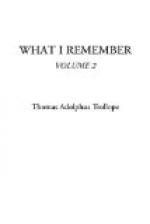I remember another somewhat analogous adventure of mine, equally illustrative of the Florentine habits of those days. I saw a man suddenly stagger and fall in the street. It was in the afternoon, and there were many persons in the street, some of them nearer to the fallen man than I was, but nobody, attempted to help him. I stepped forward to do so, and was about to take hold of him and try to raise him, when one of the by-standers eagerly caught me by the arm, saying, “He is dying, he is dying!” “Let us try to raise him,” said I, still pressing forward. “You mustn’t, you mustn’t! It is not permitted,” he added, as he perceived that he was speaking to a foreigner, and then went on to explain to me that what must be done was to call the Misericordia, for which purpose one must run and ring a certain bell attached to the chapel of that brotherhood in the Piazza del Duomo.
Among the many things that have been written of the Florentine Misericordia, I do not think that I have met with the statement that it used to be universally believed in Florence that the law gave the black brethren the privilege and the monopoly of picking up any dying or dead person in the streets, and that it was forbidden to any one else to do so. Whether any such law really existed I much doubt, but the custom of acting in accordance with it, and the belief that such practice was imperative, undoubtedly did. And I have no doubt that many a life has been sacrificed to it. The half hour or twenty minutes which necessarily elapsed before the Misericordia could be called and answer the call, must often have been supremely important, and in many cases ought to have been employed in the judicious use of the lancet.
The sight of the black robed and black cowled brethren, as they went about the streets on their errands of mercy, was common enough in Florence. But the holiday visitor had very little opportunity of hearing anything of the internal management and rules of that peculiar mediaeval society or of the nature of the work it did.
The Florentine Misericordia was founded in the days when pestilence was ravaging the city so fiercely that the dead lay uncared for in the streets, because there was no man sufficiently courageous to bury or to touch them. The members of the association, which was formed for the performance of this charitable and arduous duty, chose for themselves a costume, the object of which was the absolute concealment of the individual performing it. A loose black linen gown drapes the figure from the neck to the heels, and a black cowl, with two holes cut for the eyes, covers and effectually conceals the head and face. For more than five hundred years, up to the present day, the dress remains the same, and no human being, either of those to whom their services are rendered, or of the thousands who see them going about in the performance of their self-imposed duty, can know whether the mysterious weird-looking figure he sees be prince or peasant. He knows that he may be either, for the members of the brotherhood are drawn from all classes of society.




